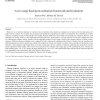920 search results - page 130 / 184 » Object Recognition from Large Structural Libraries |
BMCBI
2004
13 years 8 months ago
2004
Background: The Hotdog fold was initially identified in the structure of Escherichia coli FabA and subsequently in 4-hydroxybenzoyl-CoA thioesterase from Pseudomonas sp. strain CB...
MM
2010
ACM
13 years 8 months ago
2010
ACM
Image classification is a well-studied and hard problem in computer vision. We extend a proven solution for classifying web spam to handle images. We exploit the link structure of...
KDD
2006
ACM
14 years 8 months ago
2006
ACM
Various data mining applications involve data objects of multiple types that are related to each other, which can be naturally formulated as a k-partite graph. However, the resear...
PR
2008
13 years 8 months ago
2008
Head pose is an important indicator of a person's focus of attention. Also, head pose estimation can be used as the front-end analysis for multi-view face analysis. For examp...
CVPR
2006
IEEE
14 years 10 months ago
2006
IEEE
Coarse-to-fine classification is an efficient way of organizing object recognition in order to accommodate a large number of possible hypotheses and to systematically exploit shar...

